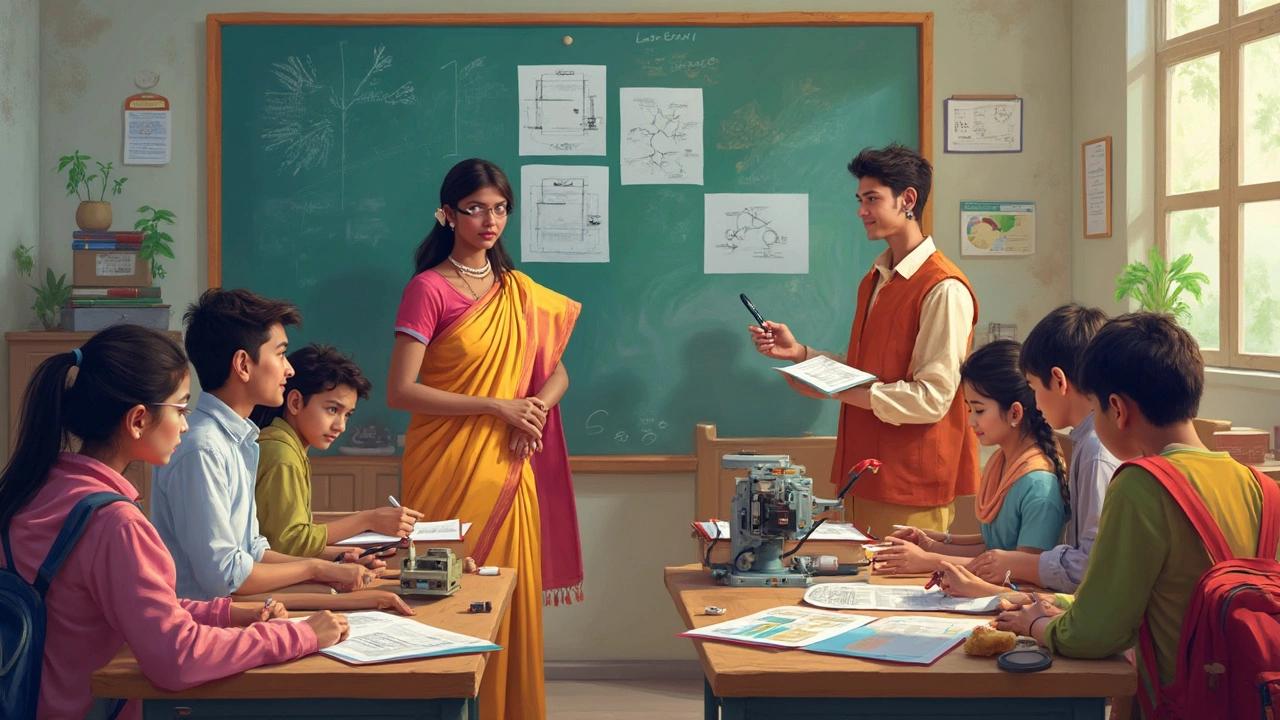Diploma vs Degree: What Sets Them Apart in India?

It's one of those questions that pops up everywhere—at family dinners, entrance exam centers, and on WhatsApp groups: is a diploma the same as a degree? The short answer is, no, they're not. But the reasons why might surprise you, especially if you grew up being told, “Just get a degree and you’ll be set for life.”
In India, these two words—diploma and degree—can make a big difference to your career, salary, and even your daily life. When my cousin Sumit finished his diploma in mechanical engineering, he landed a job before some of my friends with engineering degrees did. Sounds odd, right? But there’s more to it.
Degrees tend to be more theory-heavy, run for a longer time, and are often treated as a minimum requirement in certain white-collar jobs. Diplomas? They’re way more focused, shorter, and help folks jump straight into hands-on roles. Choosing between them isn't as simple as “which one is best”—it’s about what works for you, your goals, and how much time (and money) you want to put in.
- Diploma and Degree: The Basic Differences
- Duration, Eligibility, and Course Structure
- Career Opportunities After Each
- Tips for Choosing Between a Diploma and a Degree
Diploma and Degree: The Basic Differences
If you’re looking at diploma or degree courses in India, there’s actually a big distinction between the two. A diploma is a short-term program, usually between 1 to 3 years. Most diploma courses zoom in on a specific skill or a particular field, like nursing, electrical work, hotel management, or graphic design. A degree, on the other hand, is your traditional college route—usually lasting 3 years for something like a Bachelor of Commerce (B.Com), or 4 years for engineering or pharmacy.
Here’s another thing: diplomas are often offered by polytechnic institutes and some universities, but degrees can only be handed out by universities or institutions approved by government bodies like UGC (University Grants Commission) or AICTE. This makes a degree official and more widely accepted, especially if you're planning to go abroad or want to keep your doors open for higher education like a master’s or PhD later on.
Check this table for a quick comparison that shows where diplomas and degrees really stand apart:
| Feature | Diploma | Degree |
|---|---|---|
| Duration | 1 to 3 years | 3 to 4 years |
| Focus | Practical skills | Theory + practical |
| Eligibility | After Class 10 or 12 | After Class 12 |
| Institutions | Polytechnics, some colleges | Universities |
| Higher Education | Limited options | Full options (Postgrad, PhD) |
| Recognition Abroad | Varies, often limited | High, especially from recognized universities |
So, why the fuss? The type of certificate you pick matters for your future studies and job prospects. If you just want quick, job-ready skills, a diploma often gets you out into the workforce faster. But if you’re aiming for certain government jobs, going abroad, or higher studies, a degree is usually the safer bet. Most people don’t realize this until after they’ve already picked a course.
Duration, Eligibility, and Course Structure
If you’re weighing up whether to go for a diploma or degree in India, you need to know how long you’ll be in for, what it takes to get started, and what sort of learning you’ll actually do. Here’s how it breaks down:
Diplomas are almost always shorter. Most diploma courses in India last 1 to 3 years, with polytechnic diplomas settling into that 3-year mark after class 10, and post-12th diplomas often just taking a year. Degrees, on the other hand, are a serious time commitment. A typical bachelor’s degree runs for 3 years (like B.A., B.Sc., B.Com) and engineering and medical degrees stretch to 4 or even 5.5 years (MBBS, BTech).
| Qualification | Duration | Minimum Eligibility | Common Entry Example |
|---|---|---|---|
| Diploma | 1-3 years | 10th or 12th pass | Polytechnic, Nursing, ITI |
| Degree (Bachelor’s) | 3-5.5 years | 12th pass (relevant stream) | B.A., B.Sc., B.Com, B.Tech, MBBS |
Eligibility rules are stricter for degrees. Schools usually demand completion of class 12, and in many cases, you have to clear competitive exams like JEE for engineering or NEET for medicine. Diplomas? Much easier to get in. Some only want a class 10 certificate, especially for trades.
What about the course structure? Diplomas skip the fluff—they’re hands-on, and you’ll spend a bunch of time in labs or workshops. In a diploma in civil engineering, for example, first-year students already use surveying equipment and visit construction sites. Degree courses do have practical work but are heavier on theory, especially in the first couple of years. You'll read thick textbooks, and there’s a lot more general education mixed in.
- Diploma courses: Focused on technical or vocational skills. Great for those who want to get job-ready fast.
- Degree courses: Broader academic subjects, more in-depth studies, and higher weight in government jobs.
Something students often miss—if you finish a diploma, you might get lateral entry straight into the second year of certain degree courses in India. That’s like a shortcut if you change your mind later.

Career Opportunities After Each
Choosing between a diploma and a degree in India isn’t just about the course—it’s a big decision for your career. Here’s what really happens once you’re done with each.
If you’ve got a diploma, you’ll often find openings for roles that need skilled hands and practical knowledge. Think of jobs like technician, junior engineer, lab assistant, or graphic designer. Companies, especially in manufacturing, IT, and healthcare, hire diploma holders for entry-level or support roles because most diplomas are all about focused, job-ready skills. It’s not unusual to see people get placed faster after a diploma course than after a degree—especially in fields like polytechnic or allied health sciences.
Degrees set you up for jobs that require broader knowledge or management skills. After a degree, roles like software developer, marketing executive, research analyst, or civil engineer are open. Also, if you want to sit for government exams or go for post-graduate studies, a degree is usually a must.
“Diplomas help people get skilled and start working fast, but for those aiming at higher positions or academics, a degree is usually required.”—Prof. Anil Sahasrabudhe, former Chairman, AICTE
Now, how about the money? Here’s a look at the average starting salaries for popular jobs after each qualification, based on 2024 placement data:
| Course Type | Common Job Role | Average Starting Salary (INR/month) |
|---|---|---|
| Diploma | Junior Engineer, Technician | ₹20,000 - ₹30,000 |
| Degree | Software Developer, Analyst | ₹35,000 - ₹55,000 |
One big thing: some people start with a diploma, get a job, and then upgrade to a degree later with lateral entry or distance learning. This path brings income earlier without fully pausing education goals. Many companies value hands-on diploma holders for their ability to “hit the ground running.”
- Diploma: Fast entry to work, ideal for technical or support roles, good for those who want to start earning early.
- Degree: Opens doors for management, higher studies, and promotions. Needed for many government and private sector jobs.
For some fields, like law or medicine, only degrees count. But in IT, engineering, fashion, paramedical, or media, diplomas are a real springboard and often specifically linked to hiring trends in India’s fast-changing job market.
Tips for Choosing Between a Diploma and a Degree
You’re at the crossroads—should you go for a diploma or aim for a degree? Before you choose, think about what each option means for your future, your lifestyle, and your wallet. Here are some concrete things you should keep in mind:
- Your Career Goals: Certain jobs need a degree by law, like becoming a doctor, lawyer, or government officer. But if you want a technical job, like an electrician or a web developer, a diploma might get you working faster—and cheaper.
- Course Length and Cost: Diplomas usually wrap up in 1-2 years. Degrees in India are mostly 3-4 years (BTech is 4 years, BA and BSc are 3 years, for example). That’s more time—and tuition fees—you’ll need to pay for a degree. Here’s a quick comparison:
| Qualification | Typical Duration | Fee Range (per year, INR) |
|---|---|---|
| Diploma in Engineering | 1-3 Years | 15,000 – 40,000 |
| Bachelor’s Degree (e.g., BTech) | 4 Years | 50,000 – 2,00,000 |
- Entry Requirements: Diplomas often only need you to pass class 10 or 12, while degrees usually require higher marks and college entrance tests. Not everyone likes exams—so pick what feels right for you.
- Hands-On vs Theory: Diplomas are more about learning by doing. If you want to get practical skills and start earning soon, this could suit you. Degree courses spend more time on theory—that’s good if you plan on getting into research, teaching, or getting a postgrad degree.
- Recognition and Growth: Major companies sometimes want degree holders for higher posts and promotions. But many industries (think hospitality, design, IT support) hire diploma holders by the truckload and train them further.
One more thing—diploma holders can sometimes “upgrade” by doing a lateral entry into the second year of a degree course, especially in engineering. It means you can stack your education over time if you want to keep moving up.
Talk to people who’ve done both. Chat with teachers, seniors, or even someone like my friend Praveen, who switched from a diploma to an engineering degree after gaining real job experience. Your choice should match your style, your ambition, and your budget. There’s no right answer for everyone.

Post-Comment